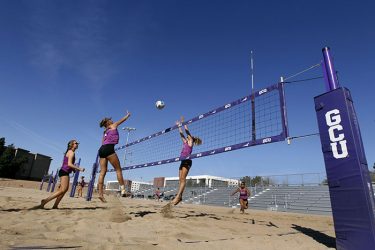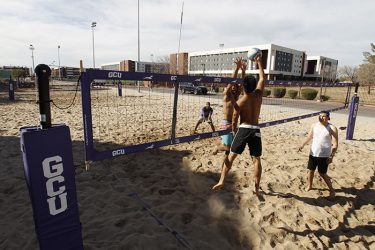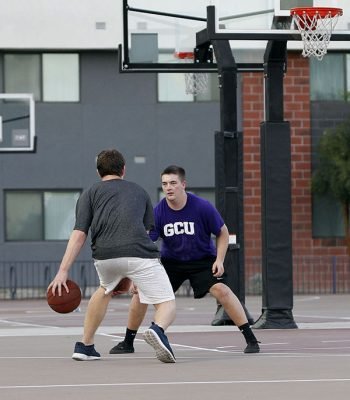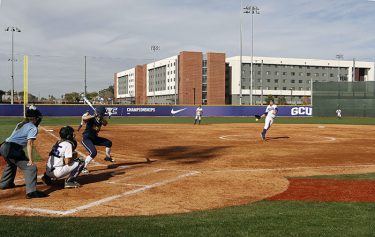Editor's note: This story is reprinted from the March issue of GCU Magazine. To view the digital version of the magazine, click here.
By Rick Vacek
GCU Magazine
Pokey Lopez has played almost every intramural sport Grand Canyon University offers. “Everything except spikeball. That’s a little hard for me,” she says.
The senior has been on campus for much of the stunning growth in the last five years. She has worked in the intramural program. And she really, really likes volleyball, in both a gym and the sand.

All that makes her eminently qualified to properly assess the impact of the latest in a long list of significant additions to the facilities available to students who view sports as a great way to take a break from homework:
Beach volleyball courts. Seven of them near the north end of campus, up from three at the previous site next to Antelope Gym. In a much roomier, inviting space. In an area where heading to the beach in midwinter requires only some suntan lotion and a few refreshments, not a parka and a sanity check.
“I think people are really excited about the new facilities just because students are able to use them more – not just for intramurals, but in general,” says Lopez, noting that she and some friends had a potluck and picnic planned for the next morning.
“At the old courts, people would wait in line for hours to play, especially the first couple of weeks when all the freshmen are so excited about the courts — ‘Ooooh, beach courts, let’s play! We’re in Arizonaaaa,’” she adds, elongating the “a” for effect. “Now, you can just go there and the courts will be open. There are so many courts to play on.”

It will have a major effect on intramurals as well. Last year, there were 65 beach volleyball teams, and the new courts give Matt Lamb, GCU’s director of intramurals, space to increase that number to 125 and also give the participants the opportunity to play more games. Add to that the indoor volleyball program, and the number of spikers and diggers is approaching 2,000.
“It always shocks me, being a guy from the Midwest (Indiana), that volleyball is extremely popular here with both men and women,” Lamb says. “Especially beach volleyball.”
The popularity of intramurals, evident on just about any weekday evening on campus, has skyrocketed during Lopez’s time at GCU. She didn’t even play IMs as a freshman because she didn’t know about them, but then she started seeing registration signs all over campus, signed up for text messages and the intramural app, and became part of the culture.
“It’s kind of like any other culture you see around campus,” she says. “Everyone knows each other, particularly on staff, and you know all the athletes who play. They’re multi-sport athletes.

“I think it’s a really good mix. You have divisions, so you have people who are really good and then people who aren’t so good. Every division is competitive in its own level.”
Of the nearly 8 million high school students who participate in athletics, only 480,000, or 6 percent, go on to play in college, according to the NCAA. So intramurals are a great way to continue to feel the rush of teamwork and maybe a little glory along the way.
“You hear people say they met their best friends by playing on an intramural team,” Lamb says. “Now that I’ve been here five years, I see people who are on the same team.”
Those relationships have been made even more possible by the installation of several other new facilities, all available to students, in the last two years: two artificial turf fields and a basketball court next to The Grove residence halls, and a massive turf field and six tennis courts on the east end of campus.
It has enabled Lamb and his staff to create the current intramural lineup — volleyball, beach volleyball, basketball, three-on-three basketball, Ultimate Frisbee, slow-pitch softball, soccer, flag football and spikeball plus table tennis and bowling tournaments. There are plans to add dodgeball, pickleball and tennis and even hold a tournament at GCU Golf Course.

And there’s another gleaming new facility to be tapped as well. GCU Stadium was the site of the intramural football championships last fall; this spring, the IM soccer title matches will be played there.
The expansion creates the opportunity to schedule more games, at more convenient times and in more divisions — and get even more students participating in intramurals. That number has increased from 1,350 students and 128 teams in 2012-13 to more than 6,100 participants on 483 teams this year.
But students who are satisfied with being intramural heroes aren’t the only ones benefiting from the campus growth. There also are the student-athletes.
In the space of a few weeks shortly after the first of the year, the beach volleyball team, which had a 10-game winning streak in 2016 on its way to an 18-8 record, and the softball team, which went 35-15 last year and tied for first place in the 2017 Western Athletic Conference Preseason Poll, both started practicing and playing games in their new facilities.
The three main beach volleyball courts sit in front of stands and are flanked by two grass berms. The team’s first event last year drew 1,400 fans even though most of them had to stand three- or four-deep, and the extra space will provide seating for 1,500 and events such as Brunch at the Beach and a pool party complete with kiddie pools.

“This is going to be one of the top facilities in the country,” GCU beach volleyball coach Kristen Rohr said. “To be able to have seven courts and run tournaments and potentially be a host for future conference tournaments and things like that, it will add a huge dimension to the program. And it will help a ton with recruiting.”
Just down Lopes Road from the beach volleyball stadium is GCU Softball Stadium, which officially opened Feb. 10. Phase I was getting the artificial turf installed, and by next year there will be a full stadium with permanent seats and an overhang protecting the 1,200 fans from the sun.
“The kids can fall in love with the campus, but there needs to be a continuation when they see the facilities they’re going to play in,” softball coach Ann Pierson says. “And that’s what President (Brian) Mueller has done for us. The campus is the ‘wow’ factor, and now you come over to the softball stadium and you just go, ‘Oh my gosh.’”
The “wow” factor also enabled Pierson to bring in highly regarded nonconference opponents, such as Washington for a doubleheader on March 22. As the stadium took shape she was reminded daily of how it affects recruits and players who’d love to be recruited.
“I get text messages all the time — ‘Oh, I went by and saw the field. It looks amazing,’” she says.
There figures to be a similar effect for coaches Dan Majerle and Trent May when the new basketball practice facility, next to GCU Arena, opens shortly. It also will include a museum dedicated to the life and career of Phoenix business icon Jerry Colangelo.
That new space will have another benefit for students: Taking the men’s and women’s practices out of the Lopes Performance Center will open another court for midday pickup games and increased intramural programming.
When Lopez first saw the campus during a Discover GCU trip in 2011, much of this expansion was merely a dream. She shakes her head when she considers what has happened during her time at the University.
“We’re always talking about how much GCU is growing and how many students are coming in,” she says.
Someone needs to tell them to pack the suntan lotion. This isn’t just a day at the beach — it’s year-round.
Contact Rick Vacek at (602) 639-8203 or [email protected].















